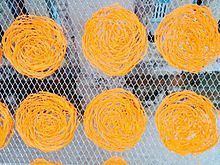 | ||
Jhilinga is a traditional Nepalese food, which is popular specially during festivals. Jhilinga is super crunchy, and is favoured by people of all age groups.
Contents
It is closely associated mostly with people of different caste like the Newars, Gurungs, Magars and many other Nepalese ethnic tribes. Popularity of Jhilinga still largely exists in villages and towns of Nepal. The making process of Jhilinga is really simple and the ingredients are not complicated as well. However people need some good hands on skill to craft it in good circles as it can be tricky to make circles out of thin soft strips and set them to cook when required . The history of Jhilinga is disputed and the dish is characterised by its frugality, reflecting agricultural hardship during ancient times. So it certainly was invented long time ago and would not surprise if someone said it was invented in one of many deep villages of Nepal. The consumption of Jhilinga is largely during different occasions like weddings and birth ceremonies. It also is associated with different other rituals and has a significant cultural importance. From early days and until now it is used as Shagun (present) ie. an offering taken when you visit guests or relatives houses.
Ingredients
Method
Boil water in a deep casserole. Slowly add the required rice flour and food color into the boiling water and stir constantly with wooden spoon. It is same a process of making dhindo but without the ghee. The mixture should have a good balance and consistency of flour and water . After it is cooked, process through noodle machine which can make really thin strips. It needs lots of practice, softness and hands full of skill to make a circle out of the moist rice strips. After it is carefully crafted into circles it needs couple of days out in the sun to be properly set. That is how it is still made using the pure source of heat directly from the sun.
Once it is evenly set, it is ready to be deep fried in a vegetable oil or in a pure mustard oil processed in local mill.
